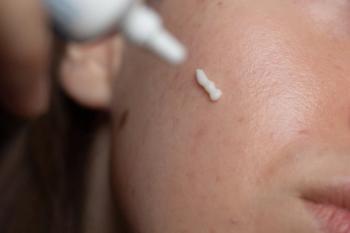
Late-Breaking Data: Real-World Registry Data Supports Upadacitinib Efficacy in Moderate to Severe AD, Regardless of Biologic History
Key Takeaways
- Upadacitinib demonstrated significant effectiveness in treating moderate to severe AD in real-world settings, with substantial improvements in skin clearance and itch reduction.
- The study included 192 patients, both bio-naïve and bio-experienced, showing that prior biologic use does not significantly diminish upadacitinib's therapeutic benefits.
At RAD 2025, Christopher Bunick, MD, PhD, presented 6-month data from the CorEvitas AD Registry, highlighting clinically meaningful skin clearance, itch reduction, and more in bio-naïve and bio-experienced adults treated with upadacitinib.
At the
At RAD, Christopher Bunick, MD, PhD, editor in chief of Dermatology Times and associate professor of dermatology at Yale School of Medicine in New Haven, Connecticut, presented the late-breaking data.
“Ultimately, what does this tell us? It tells us in the real world that upadicitinib has been shown to be very effective at the 6-month mark in achieving the most stringent outcomes, minimal disease activity, and improving quality of life of patients, both for bio-naïve and bio-experienced patients,” Bunick said.
Background
The Registry is a prospective, noninterventional registry for adults with AD in the
United States and Canada receiving care from a dermatologist or qualified physician, including over 4000 patients across over 80 study sites. Patients were enrolled in the Registry if they were aged 18 years or older, had a diagnosis of AD from a dermatologist, and began receiving treatment with an eligible medication (including biologics, small molecules, nonbiologic systemics, or systemic corticosteroids) at or within 12 months prior to the enrollment visit.
Skin clearance was assessed by a vIGA-AD score of 0 or 1 (vIGA-AD 0/1) among patients with a baseline vIGA-AD score of greater than 1 and an EASI score improvement ≥90% or 100% from baseline (EASI 90/100). Worst itch was assessed by no/minimal itch (PP-NRS 0/1): PP-NRS score 0 or 1 among patients with a baseline PP-NRS score greater than 1. Quality of life was assessed by no impact on QoL (DLQI 0/1): DLQI score 0 or 1 among patients with a baseline DLQI score greater than 1. Disease control was assessed by well-controlled disease (ADCT <7): ADCT score greater than 7 among patients with a baseline ADCT score ≥7. Simultaneous Skin and Itch Improvement (minimal disease activity; MDA) was assessed by complete or almost complete skin clearance and itch relief (EASI 90 and PP-NRS 0/1): EASI score improvement ≥90% and PP-NRS score 0 or 1 among participants with a baseline PP-NRS score >1.
Results
The study evaluated 192 patients over a 6-month period, categorizing patients based on prior biologic therapy exposure. Approximately 44% of patients had previous biologic use, with a subset having been treated with dupilumab or tralokinumab. Patients who received upadacitinib achieved substantial improvements in key disease metrics. More patients in both the bio-naïve and bio-experience group started on upadacitinib 15mg, compared to 30mg. After 6 months, 6 bio-naïve patients increased their dosage and 2 decreased dosage, and 12 bio-experienced patients increased dosage.
Notably, in the bio-naïve cohort (n=108), 68.5% reached EASI 90, and 52.1% achieved no or minimal itch (PP-NRS 0/1) after 6 months. The bio-experienced group (n=84) demonstrated comparable outcomes, with 52.6% attaining EASI 90 and 34.7% achieving PP-NRS 0/1. Overall, many patients achieved minimal disease activity (MDA), defined as simultaneous achievement of EASI 90 and PP-NRS 0/1, with 68.7% in the bio-naïve and 36.2% in the bio-experienced groups.
According to the data, these findings align with phase 3 clinical trial efficacy data, supporting upadacitinib utility in routine practice across diverse patient populations, including those with prior biologic exposure. The data suggest that prior biologic use does not markedly diminish upadacitinib’s therapeutic benefits, further proving its role as an effective option for difficult-to-treat patients with AD.
Limitations of the study include the observational design and potential selection bias inherent in registry data.
Overall, 6 months of upadacitinib treatment in a real-world setting yields high rates of skin clearance and itch reduction, regardless of prior biologic therapy status. According to Silverberg et al, these results reinforce upadacitinib's position as a versatile systemic therapy for moderate to severe AD in routine dermatologic care. Further longitudinal analyses will clarify its long-term safety and durability of response.
Reference
- Silverberg JI, Gooderham M, Bunick CG, et al. real-world effectiveness of upadacitinib in moderate‑to‑severe atopic dermatitis (AD) in bio‑experienced and bio-naïve patients: results from longitudinal analyses of the CorEvitas AD registry. Poster presented at: 2025 Revolutionizing Atopic Dermatitis Conference; June 6-7, 2025; Nashville, TN
Newsletter
Like what you’re reading? Subscribe to Dermatology Times for weekly updates on therapies, innovations, and real-world practice tips.


















